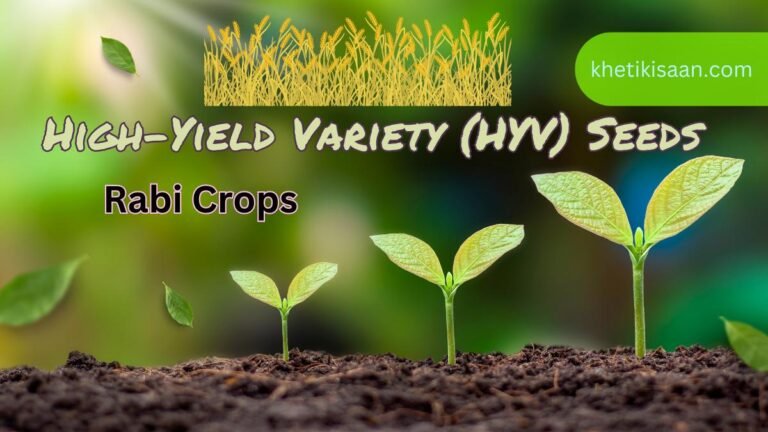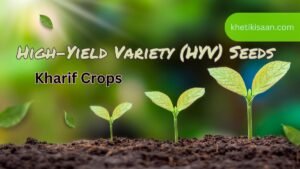High-yield variety (HYV) seeds are a big step forward in farming tech. They help crops grow better & faster. Farmers breed these seeds to make plants that have great traits. This includes things like better yields, being tough against diseases, & fitting different climates. Since HYV seeds have come along, they’ve really changed how farmers work, especially for Rabi crops in India that do well in cooler months.
HYV seeds started back during the Green Revolution in the 1960s. Back then, scientists & farmers teamed up to create varieties to feed more people. The focus was on staple foods like Wheat and Rice. These crops were made to grow quicker, use nutrients better, & give more food per area. In India, using HYV seeds changed farming for the better, helping boost food supply & security.
For Rabi crops in India, HYV seeds are super important because they can yield more even in challenging situations where regular seeds struggle. They help farmers keep growing enough food even in places with few resources. This is key for staying firm against climate changes or crop failures. Plus, as people keep increasing & cities grow more extensive, it’s more important than ever to ensure there’s enough food. With HYV seeds, farmers can tackle these problems better and keep a steady supply of crucial crops while also helping rural economies stay strong.
Popular High-Yield Varieties for Rabi Crops
When it comes to Rabi farming in India, using HYV seeds has really boosted the amount of food we can grow. Some of the top wheat types, like HD 2967 & PBW 343, are known for their excellent yields and toughness against diseases. HD 2967 is good because it resists yellow rust and takes around 120 days to mature—pretty handy for many areas across India! PBW 343 is another favourite since it can produce about 6 tons per hectare when conditions are just right. It’s especially liked in Punjab and Haryana.
Barley is also an important crop, with high-yield seeds like DWR 195 and DWR 28 making waves. DWR 195 is noted for its early harvest time & ability to fight off some foliar diseases, which makes it popular with farmers up north. On the flip side, DWR 28 holds up well against water shortages. It works with different soil kinds—ideal for regions where rain isn’t consistent.
Mustard is another key crop where high-yield types like RH 30 and Varuna come into play. RH 30 is known for maturing early & having tons of oil content, which helps farmers rotate their crops smartly—especially in places like Rajasthan & Haryana! Varuna stands out because it’s tough against downy mildew so it can survive many weather situations. Also, gram varieties such as HG 365 and Vijay are solid picks as they handle drought well and work fine on harsh lands, which helps sustainable farming thrive.
Focusing on high-yield varieties for Rabi crops has really helped boost food security and improve farmer lives while fitting farming plans to local needs.
Advantages of High-Yield Variety Seeds over Traditional Seeds
India’s farming scene has really changed thanks to high-yield variety (HYV) seeds for Rabi crops. The new seeds are built to give bigger yields compared to old-school types—the difference is enormous! This plays a vital role in boosting food security and getting farmers better incomes. With smarter genetics, they can give out more from the same land, making farms run smoother & and more eco-friendly.
One essential perk of using HYV seeds for Rabi crops is that they’re tougher against pests and diseases. Regular seeds usually face lots of problems from bugs or illnesses, leading to lost harvests. But not these! HYV seeds are made to handle those issues, so farmers rely less on chemicals—this means healthier farming practices overall.
Another big plus? The way HYV seeds adapt to different climates makes a real difference, too! With climate change shaking things up with wild weather patterns, farmers need crops that won’t back down easily under stress. HYV seeds show greater strength and flexibility, letting them grow even when mother nature isn’t playing nice with drought or heavy rains.
From a money angle, using high-yield variety seeds can lead to better paychecks for farmers in India. With more yields, they might get extra food they can sell; that’s good news! More income could lead them to invest in better farming techniques that help whole communities improve!
But it’s not all rainbows and butterflies; there are obstacles, too! Getting quality seeds at first can be costly, which might weigh on some folks’ pockets. Plus, sticking too much to just a few seed types could risk biodiversity disappearing from farms. All these hurdles need attention if we want healthy farming practices around here!
Future Prospects of HYV Seeds in Rabi Farming
Talk about high-yield variety (HYV) seeds for rabi crops in India, and it’s clear they play a big part in boosting farming and helping with food security. India has some tough challenges, like climate change and a growing population. Using HYV seeds can help meet the rising need for food. These seeds have benefits, too, like being more robust against weather changes & giving better crop yields. They’re essential for rabi farming.
Looking ahead, using these high-yield seeds in rabi farming should go hand in hand with sustainable practices. As worries about the environment grow, we need to use organic fertilizers, rotate crops, and manage resources wisely. It’s super crucial for researchers & policymakers to push for new HYV seed kinds that don’t just give high yields but can also handle brutal weather & pests. This way, farmers can get steady and reliable harvests.
Plus, education and training for farmers are a must. Programs that help them learn advanced farming techniques and how to use HYV seeds well can really improve their productivity. When agricultural researchers, the government, & farming communities work together, they can share helpful information that leads to bigger harvests and better lives.
The future of high-yield variety seeds for rabi crops in India looks bright. With focused efforts on research, sustainable methods, & farmer education, the agriculture sector can make significant progress. This will help increase efficiency while tackling food security issues in our changing climate.


